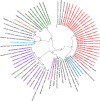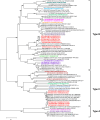Epidemiology and molecular detection of human adenovirus and non-polio enterovirus in fecal samples of children with acute gastroenteritis: A five-year surveillance in northern Brazil
- PMID: 39093896
- PMCID: PMC11296658
- DOI: 10.1371/journal.pone.0296568
Epidemiology and molecular detection of human adenovirus and non-polio enterovirus in fecal samples of children with acute gastroenteritis: A five-year surveillance in northern Brazil
Abstract
Acute gastroenteritis (AGE) is a common pediatric infection that remains a significant cause of childhood morbidity and mortality worldwide, especially in low-income regions. Thus, the objective of this study was to detect human adenovirus (HAdV) and non-polio enterovirus (NPEV) in fecal samples from the Gastroenteritis Surveillance Network, and to identify circulating strains by nucleotide sequencing. A total of 801 fecal samples were tested using qPCR/RT-qPCR, and 657 (82.0%) were inoculated into HEp-2C and RD cell lines. The HAdV and NPEV positivity rates obtained using qPCR/RT-qPCR were 31.7% (254/801) and 10.5% (84/801), respectively, with 5.4% (43/801) co-detection. Cytopathic effect was observed in 9.6% (63/657) of patients, 2.7% (18/657) associated with HAdV, and 6.2% (41/657) associated with NPEV after testing by ICC-PCR. A comparison of the two methodologies demonstrated an agreement of 93.5% for EVNP and 64.4% for HAdV. These two viruses were detected throughout the study period, with HAdV positivity rates ranging from 41% in Amapá to 18% in Pará. The NEPV varied from 18% in Pará/Rondônia to 3% in Acre. The most affected age group was over 60 months for both HAdV and NPEV. Samples previously positive for rotavirus and norovirus, which did not show a major difference in the presence or absence of diarrhea, fever, and vomiting, were excluded from the clinical analyses of these two viruses. These viruses circulated over five years, with a few months of absence, mainly during the months corresponding to the waves of SARS-CoV-2 infection in Brazil. Five HAdV species were identified (A, B, C, D, and F), with a greater predominance of HAdV-F41 (56.5%) followed by HAdV-C (15.2%). Three NPEV species (A, B, and C) were detected, with serotypes E14 (19.3%) and CVA-24 (16.1%) being the most prevalent. The present study revealed a high diversity of NPEV and HAdV types circulating in children with AGE symptoms in the northern region of Brazil.
Copyright: © 2024 Alves et al. This is an open access article distributed under the terms of the Creative Commons Attribution License, which permits unrestricted use, distribution, and reproduction in any medium, provided the original author and source are credited.
Conflict of interest statement
The authors have declared that no competing interests exist.
Figures



Similar articles
-
Molecular Epidemiology of Human Adenovirus from Acute Gastroenteritis Cases in Brazil After the COVID-19 Pandemic Period, 2021-2023.Viruses. 2025 Apr 17;17(4):577. doi: 10.3390/v17040577. Viruses. 2025. PMID: 40285019 Free PMC article.
-
Viral gastroenteritis in Tocantins, Brazil: characterizing the diversity of human adenovirus F through next-generation sequencing and bioinformatics.J Gen Virol. 2020 Dec;101(12):1280-1288. doi: 10.1099/jgv.0.001500. Epub 2020 Oct 12. J Gen Virol. 2020. PMID: 33044150
-
Surveillance and molecular characterization of human adenovirus in patients with acute gastroenteritis in the era of rotavirus vaccine, Brazil, 2012-2017.J Clin Virol. 2018 Dec;109:35-40. doi: 10.1016/j.jcv.2018.10.010. Epub 2018 Nov 1. J Clin Virol. 2018. PMID: 30399502
-
Pediatric acute gastroenteritis associated with adenovirus 40/41 in low-income and middle-income countries.Curr Opin Infect Dis. 2020 Oct;33(5):398-403. doi: 10.1097/QCO.0000000000000663. Curr Opin Infect Dis. 2020. PMID: 32773498 Free PMC article. Review.
-
Human adenoviruses in children with gastroenteritis: a systematic review and meta-analysis.BMC Infect Dis. 2024 May 9;24(1):478. doi: 10.1186/s12879-024-09386-x. BMC Infect Dis. 2024. PMID: 38724898 Free PMC article.
Cited by
-
Enterovirus D68 Subgenotype B3 Circulation in Children with Acute Respiratory Illness in the State of Alagoas, Brazil.Viruses. 2025 Feb 11;17(2):242. doi: 10.3390/v17020242. Viruses. 2025. PMID: 40006997 Free PMC article.
-
Molecular Epidemiology of Human Adenovirus from Acute Gastroenteritis Cases in Brazil After the COVID-19 Pandemic Period, 2021-2023.Viruses. 2025 Apr 17;17(4):577. doi: 10.3390/v17040577. Viruses. 2025. PMID: 40285019 Free PMC article.
-
Beyond Poliomyelitis: A 21-Year Study of Non-Polio Enterovirus Genotyping and Its Relevance in Acute Flaccid Paralysis in São Paulo, Brazil.Viruses. 2024 Dec 1;16(12):1875. doi: 10.3390/v16121875. Viruses. 2024. PMID: 39772185 Free PMC article.
-
Viral metagenomics reveals diverse viruses in the fecal samples of children with acute respiratory infection.Front Microbiol. 2025 Apr 7;16:1564755. doi: 10.3389/fmicb.2025.1564755. eCollection 2025. Front Microbiol. 2025. PMID: 40260089 Free PMC article.
-
Evaluating enterovirus diversity among symptomatic patients in Hungary during and after easing the COVID-19 lockdown.Virol J. 2025 Jun 24;22(1):204. doi: 10.1186/s12985-025-02835-2. Virol J. 2025. PMID: 40555984 Free PMC article.
References
-
- Perin J, Mulick A, Yeung D, Villavicencio F, Lopez G, Strong KL, et al.. Global, Regional, and National Causes of under-5 Mortality in 2000–19: An Updated Systematic Analysis with Implications for the Sustainable Development Goals. Lancet Child Adolesc Health. 2022:6: 106–115. doi: 10.1016/S2352-4642(21)00311-4 - DOI - PMC - PubMed
-
- Hartman S, Brown E, Loomis E, Russell HA. Gastroenteritis in Children. Am Fam Physician. 2019: 99(3): 159–165. Erratum in: Am Fam Physician. 2019: 99(12): 732. - PubMed
-
- Akdag AI, Gupta S, Khan N, Upadhayay A, Ray P. Epidemiology and clinical features of rotavirus, adenovirus, and astrovirus infections and coinfections in children with acute gastroenteritis prior to rotavirus vaccine introduction in Meerut, North India. J Med Virol. 2020: 92:1102–1109. doi: 10.1002/jmv.25645 - DOI - PubMed
-
- Farahmand M, Moghoofei M, Dorost A, Shoja Z, Ghorbani S, Kiani SJ, et al.. Global prevalence and genotype distribution of norovirus infection in children with gastroenteritis: A meta-analysis on 6 years of research from 2015 to 2020. Rev Med Virol. 2022: 32: 2237. doi: 10.1002/rmv.2237 - DOI - PubMed
MeSH terms
LinkOut - more resources
Full Text Sources
Medical
Miscellaneous

